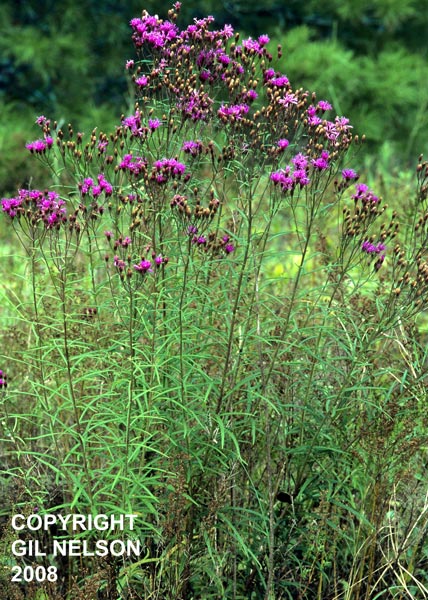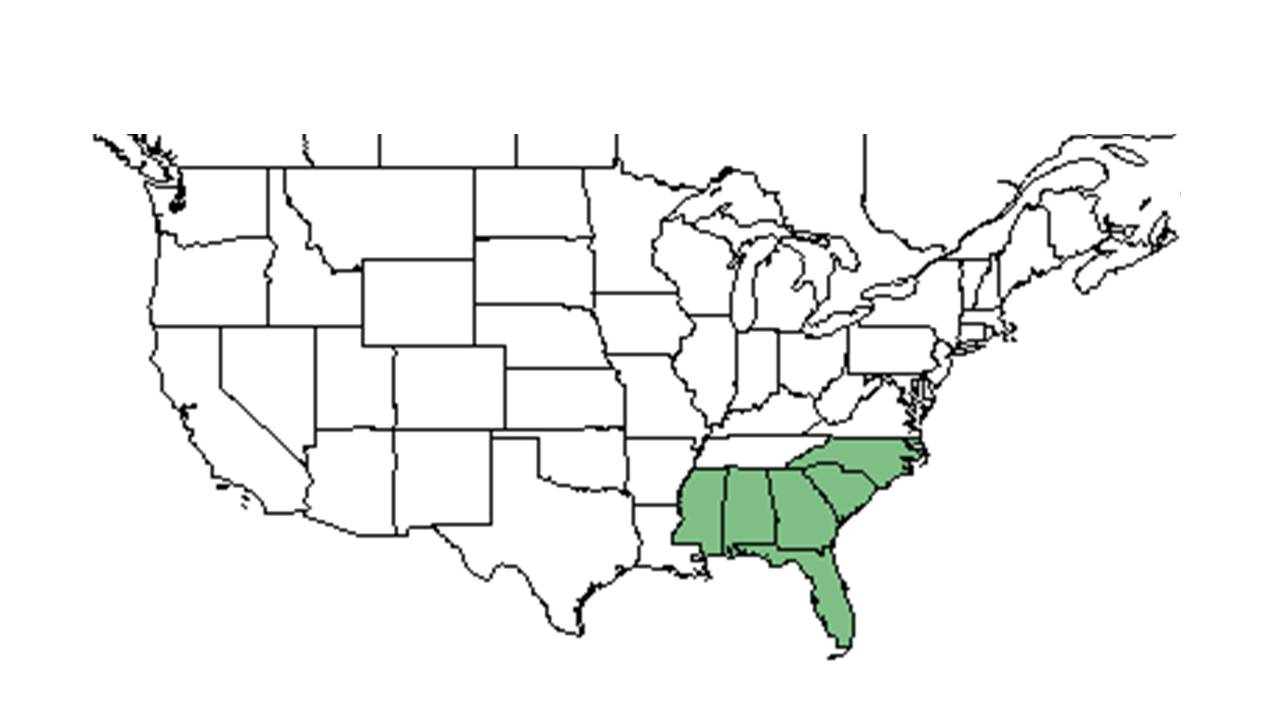Difference between revisions of "Vernonia angustifolia"
(→Ecology) |
|||
| Line 50: | Line 50: | ||
<!--===Pollination===--> | <!--===Pollination===--> | ||
| − | === | + | ===Pollination and use by animals=== <!--Herbivory, granivory, insect hosting, etc.--> |
| − | In Southeastern pine savannas, ''V. angustifolia'' was found in 6.25% of the active gopher tortoise (''Gopherus polyphemus'') burrows<ref name=birk/> and is a nectar plant for native pollinators.<ref>Denhof, Carol. 2013. Understory Plant Spotlight Tall Ironweed Vernonia angustifolia Michx. The Longleaf Leader. Vol. VI. Iss. 4. Page 9</ref> | + | ''Vernonia angustifolia'' has been observed with leafcutting bees such as ''Megachile mendica'' (family Megachilidae).<ref>Discoverlife.org [https://www.discoverlife.org/20/q?search=Bidens+albaDiscoverlife.org|Discoverlife.org]</ref> In Southeastern pine savannas, ''V. angustifolia'' was found in 6.25% of the active gopher tortoise (''Gopherus polyphemus'') burrows<ref name=birk/> and is a nectar plant for native pollinators.<ref>Denhof, Carol. 2013. Understory Plant Spotlight Tall Ironweed Vernonia angustifolia Michx. The Longleaf Leader. Vol. VI. Iss. 4. Page 9</ref> |
<!--===Diseases and parasites===--> | <!--===Diseases and parasites===--> | ||
Revision as of 18:35, 21 June 2021
| Vernonia angustifolia | |
|---|---|

| |
| Photo taken by Gil Nelson | |
| Scientific classification | |
| Kingdom: | Plantae |
| Division: | Magnoliophyta – Flowering plants |
| Class: | Magnoliopsida – Dicotyledons |
| Order: | Asterales |
| Family: | Asteraceae ⁄ Compositae |
| Genus: | Vernonia |
| Species: | V. angustifolia |
| Binomial name | |
| Vernonia angustifolia Michx. | |

| |
| Natural range of Vernonia angustifolia from USDA NRCS Plants Database. | |
Common name: Tall ironweed
Contents
[hide]Taxonomic notes
Varieties: Vernonia angustifolia Michaux var. angustifolia; Vernonia angustifolia Michaux var. mohrii S.B. Jones; Vernonia angustifolia Michaux var. scaberrima (Nuttall) A. Gray.[1]
Description
A description of Vernonia angustifolia is provided in The Flora of North America.
Distribution
Ironweed is found throughout the southeastern coastal plains region from North Carolina to Florida to Mississippi.[2]
Ecology
Habitat
In the Coastal Plain region, V. angustifolia can be found in sand pine scrubs, longleaf pine-wiregrass flatwoods, edges of meadows, pine-turkey oak flats, longleaf pine savannas, mixed woodlands adjacent to floodplains, annually burned pinelands, longleaf pine-sedge-andropogon savannas, slash pine-wiregrass flats, oak scrubs, second growth hardwoods, cabbage palm hammocks, annually burned upland pines[3][4] and sandhill communities.[5] It can also be found along roadsides, power line corridors, bulldozed pine-oak scrubs, and clobbered slash pine forests. Soil types include sandy loam, loose sand, loamy sands, sandy peat[4], and Utisols[6] Associated species include Aristida, Serenoa repens, Ilex glabra, Liatris, Andropogon, Panicum, and Leptoloma cognata.[4]
V. angustifolia responds negatively to agriculture-based soil disturbance in South Carolina's historically longleaf communities.[7] This could also mark it as a possible indicator species for remnant woodland.[8] When exposed to soil disturbance by military training in West Georgia, V. angustifolia responds negatively by way of absence.[9] It also responds negatively to soil disturbance by agriculture in Southwest Georgia.[10]
Vernonia angustifolia is frequent and abundant in the North Florida Subxeric Sandhills community type and is an indicator species for the Clayhill Longleaf Woodlands community type as described in Carr et al. (2010).[11]
Phenology
V. angustifolia is a fall forb.[12] Showy-flowered sandhill species.[5] It has been observed flowering in January and June through October and fruits June through October.[4][13]
Seed dispersal
This species is thought to be dispersed by wind.[14]
Seed bank and germination
Less than 1% of V. angustifolia seeds remained viable after two years of burial.[6] So V. angustifolia does not have a short-term persistent soil seed bank and has little seed dormancy.[6]
Fire ecology
It can live in areas frequently burned.[6]
Pollination and use by animals
Vernonia angustifolia has been observed with leafcutting bees such as Megachile mendica (family Megachilidae).[15] In Southeastern pine savannas, V. angustifolia was found in 6.25% of the active gopher tortoise (Gopherus polyphemus) burrows[3] and is a nectar plant for native pollinators.[16]
Conservation, cultivation, and restoration
Cultural use
Photo Gallery
References and notes
- Jump up ↑ Weakley, A.S. 2015. Flora of the southern and mid-atlantic states. Working Draf of 21 May 2015. University of North Carolina at Chapel Hill, Chapel Hill, North Carolina.
- Jump up ↑ Denhof, Carol. 2013. Understory Plant Spotlight Tall Ironweed Vernonia angustifolia Michx. The Longleaf Leader. Vol. VI. Iss. 4. Page 9
- ↑ Jump up to: 3.0 3.1 Birkhead, R. D., C. Guyer, et al. (2005). "Patterns of folivory and seed ingestion by gopher tortoises (Gopherus polyphemus) in a southeastern pine savanna." American Midland Naturalist 154: 143-151.
- ↑ Jump up to: 4.0 4.1 4.2 4.3 Florida State University Robert K. Godfrey Herbarium database. URL: http://herbarium.bio.fsu.edu. Last accessed: July 2015. Collectors: Loran C. Anderson, Robert K. Godfrey, Nancy E. Jordan, R. Kral, K. Craddock Burks, Andre F. Clewell, P. L. Redfearn, Samuel B. Jones, Richard S. Mitchell, John C. Ogden, H. E. Grelen, James D. Ray, Jr., Gwynn W. Ramsey, E. S. Ford, C. Jackson, Robert L. Lazor, John D. Lazor, Gary R. Knight, Rodie White, R. A. Norris, R. Komarek, M. Davis, MacClendons, G. Wilder, Cecil R Slaughter. States and Counties: Florida: Bay, Calhoun, Citrus, Columbia, Duval, Escambia, Flagler, Franklin, Gadsden, Hernando, Highlands, Jackson, Lake, Leon, Liberty, Martin, Nassau, Okaloosa, Santa Rosa, Seminole, Suwannee, Taylor, Wakulla, Washington. Georgia: Baker, Coffee, Grady, Thomas. Compiled by Tall Timbers Research Station and Land Conservancy.
- ↑ Jump up to: 5.0 5.1 Heuberger, K. A. and F. E. Putz (2003). "Fire in the suburbs: ecological impacts of prescribed fire in small remnants of longleaf pine (Pinus palustris) sandhill." Restoration Ecology 11: 72-81.
- ↑ Jump up to: 6.0 6.1 6.2 6.3 Coffey, K. L. and L. K. Kirkman (2006). "Seed germination strategies of species with restoration potential in a fire-maintained pine savanna." Natural Areas Journal 26: 289-299.
- Jump up ↑ Brudvig, L.A. and E.I. Damchen. (2011). Land-use history, historical connectivity, and land management interact to determine longleaf pine woodland understory richness and composition. Ecography 34: 257-266.
- Jump up ↑ Brudvig, L.A., E Grman, C.W. Habeck, and J.A. Ledvina. (2013). Strong legacy of agricultural land use on soils and understory plant communities in longleaf pine woodlands. Forest Ecology and Management 310: 944-955.
- Jump up ↑ Dale, V.H., S.C. Beyeler, and B. Jackson. (2002). Understory vegetation indicators of anthropogenic disturbance in longleaf pine forests at Fort Benning, Georgia, USA. Ecological Indicators 1(3):155-170.
- Jump up ↑ Kirkman, L.K., K.L. Coffey, R.J. Mitchell, and E.B. Moser. Ground Cover Recovery Patterns and Life-History Traits: Implications for Restoration Obstacles and Opportunities in a Species-Rich Savanna. (2004). Journal of Ecology 92(3):409-421.
- Jump up ↑ Carr, S.C., K.M. Robertson, and R.K. Peet. 2010. A vegetation classification of fire-dependent pinelands of Florida. Castanea 75:153-189.
- Jump up ↑ Kirkman, L. K., K. L. Coffey, et al. (2004). "Ground cover recovery patterns and life-history traits: implications for restoration obstacles and opportunities in a species-rich savanna." Journal of Ecology 92: 409-421.
- Jump up ↑ Nelson, G. PanFlora: Plant data for the eastern United States with emphasis on the Southeastern Coastal Plains, Florida, and the Florida Panhandle. www.gilnelson.com/PanFlora/ Accessed: 15 DEC 2016
- Jump up ↑ Kirkman, L. Katherine. Unpublished database of seed dispersal mode of plants found in Coastal Plain longleaf pine-grasslands of the Jones Ecological Research Center, Georgia.
- Jump up ↑ Discoverlife.org [1]
- Jump up ↑ Denhof, Carol. 2013. Understory Plant Spotlight Tall Ironweed Vernonia angustifolia Michx. The Longleaf Leader. Vol. VI. Iss. 4. Page 9
